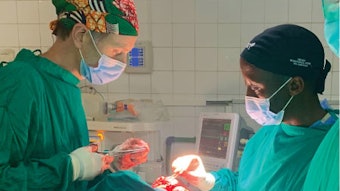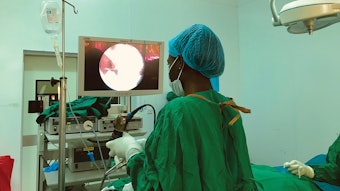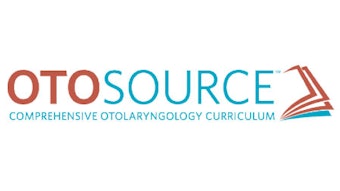Out of Committee: Outcomes Research and Evidence-Based Medicine | De-escalation of Adjuvant Treatment for HPV+ Oropharyngeal Cancer: TORS and ECOG 3311
Evidence has been building for the potential of TORS to further stratify the dichotomous treatment of oropharyngeal squamous cell carcinoma by identifying patients who may be eligible for further de-escalation based on low-risk pathology.
Kevin J. Contrera, MD, MPH; Neil D. Gross, MD; Mihir R. Patel, MD; Vikas Mehta, MD; Robert L. Ferris, MD, members of the Outcomes Research and Evidence-Based Medicine Committee
Can Transoral Robotic Surgery (TORS) Reduce Radiation Toxicity in Select Patients?
Standard treatment for locoregionally advanced oropharyngeal cancer has traditionally been offered to patients via two pathways: chemoradiation (70 Gy + platinum-based chemotherapy) or surgery followed by radiation (60 Gy +/- chemotherapy). Evidence has been building for the potential of TORS to further stratify the dichotomous treatment of oropharyngeal squamous cell carcinoma by identifying patients who may be eligible for further de-escalation based on low-risk pathology. No study added to that evidence more than the Eastern Cooperative Oncology Group – American College of Radiology Imaging Network (ECOG-ACRIN) 3311, formally known as “Transoral Surgery Followed by Low-Dose or Standard-Dose Radiation Therapy with or without Chemotherapy in Treating Patients with HPV Positive Stage III-IVA Oropharyngeal Cancer.” This article updates readers on this study and the status of de-escalation of oropharyngeal cancer treatment.
Review of the Protocol
The study took patients with AJCC 7th Stage III-IV (cT1-2, N1-2b) HPV+ oropharyngeal squamous cell carcinoma (OPSCC) who were undergoing transoral resection with neck dissection and stratified them into four arms based on risk. Patients at low risk (Arm A: pT1-2N0-1, ≥ 3 mm margins) were observed without adjuvant treatment. High-risk patients (Arm D), namely those with positive margins, extranodal extension (ENE) ≥ 1 mm, or > 4 metastatic nodes, underwent adjuvant chemoradiation (66 Gy and cisplatin). Patients at intermediate risk (close margins, < 1 mm of ENE, or 2-4 metastatic nodes, perineural invasion or lymphovascular invasion) were randomized to 50 Gy (Arm B) or 60 Gy (Arm C) of adjuvant radiation. In addition to progression-free and overall survival, the study evaluated both functional and quality of life assessments.
Current Status
From 2013 to 2017, 68 credentialed surgeons across the country performed 519 TORS surgeries. This, in itself, was a milestone for the specialty in terms of multi-institutional coordination, led by Robert L. Ferris, MD, PhD, and Chris Holsinger, MD.1 Positive margins occurred in 4% of patients. Severe bleeding (Grade III/IV) occurred in 5% of patients, with one death (Grade V) in approximately 500 patients (0.2%).
The initial results of the study have been presented at American Society of Clinical Oncology (ASCO) 2020 Virtual Annual Meeting, and updated with 3-year survival at ASCO 2021, and the manuscript is currently in press.2 Three-year progression-free survival was approximately 95% in the experimental, low-dose radiation group (Arm B), which was the same as the standard dose radiation group (Arm C). In fact, progression-free survival was greater than 90% in all four arms (A: 96.9% [90% CI 91.9-100], B: 94.9% [91.3-98.6], C: 93.5% [89.4-97.9], D: 90.7% [86.2-95.4]). Overall survival was similar for all arms (A: 100% [90% CI 100-100), B: 99.0% [97.3-100], C: 95.0% [91.5-98.7], D: 93.3% [89.4-97.4]). Patients receiving adjuvant radiation alone compared to adjuvant chemoradiation (intermediate vs. high-risk arms) were found to have better swallowing. Among the intermediate group, the lower intensity radiation arm appeared to have improved functional outcomes, although this data should be interpreted with caution as these groups do not have the same baseline risk, and long-term follow-up data are pending.
What We Currently Know
ECOG-ACRIN 3311 has helped clinicians understand the role of TORS for patients with locoregionally advanced HPV+ oropharyngeal cancer. The study establishes that TORS is safe in this population and can achieve favorable oncologic outcomes. Swallowing results were also better in the low-dose arm. Furthermore, this study has provided a template for appropriate de-escalation of adjuvant treatment. Most notably, for patients with negative margins, < 5 metastatic nodes, and no extensive ENE (> 1mm), treatment radiation doses are meaningfully reduced without the need for chemotherapy in roughly 70% of patients. Regardless of the advances with TORS, patients who are anticipated to be in the high-risk group (≥ 1 mm ENE, likely positive margins, > 4 nodes) are generally favored to undergo definitive chemoradiation rather than trimodality treatment (surgery followed by adjuvant chemoradiation.) Nevertheless, treatment of head and neck cancer requires an individualized approach, and these preliminary findings only serve as a guideline for management.
What We Still Need to Know
While this study demonstrates outstanding outcomes after TORS for HPV+ OPSCC, there are still many questions remaining. Our ability to preoperatively identify high-risk patients who might be best served by chemoradiation is limited.3 Additionally, the prognostic implications of tobacco abuse in HPV + OPSCC and how it impacts treatment outcomes for the different modalities have yet to be fully elucidated.4 More importantly, debate still exists as to how surgery with adjuvant radiation compares to chemoradiation for patients at intermediate risk. A phase III trial comparing surgery with adjuvant radiation to platinum-based chemoradiation is currently in development. This phase III prospective trial is designed to maximize accrual of intermediate-risk patients with HPV+ oropharyngeal cancer by identifying those with < 1 mm ENE. They will be stratified based on age, pack-year smoking history, and primary disease site (tongue base and glossopharyngeal sulcus vs. tonsil) before randomization to surgery or chemoradiation (70 Gy + cisplatin, the current standard of care based on Radiation Therapy Oncology Group [RTOG] 1016). The surgical arm will undergo pathologically driven adjuvant therapy identical to ECOG-ACRIN 3311.
Currently, the upcoming trial is designed as a non-inferiority study with overall survival as the primary endpoint. However, a head-to-head study comparing surgery with/without adjuvant radiation to platinum-based chemoradiation may necessitate as many as 1,500 patients to discern a meaningful difference. If such a trial is not feasible, are the results from ECOG-ACRIN 3311 convincing enough to adopt surgery as the standard of care for intermediate-risk patients? ECOG-ACRIN 3311 is arguably practice-changing by demonstrating that pathologically driven de-escalation is possible to improve functional outcomes while maintaining the excellent prognosis for select patients afflicted with HPV+ oropharyngeal cancer. While the field has adopted a variety of de-escalation treatment algorithms, we must continue to proceed with caution as some studies have found that certain de-escalation strategies can worsen survival.5 Single-institution trials are invaluable in exploring what is possible. However, to truly shift the paradigm and deepen our understanding of which patients will benefit best from surgery, we will need collaborative, phase III multi-institutional prospective investigations that are adequately powered to test the age-old question: surgery versus chemoradiation.
The content of this article was developed in partnership with the American Academy of Otolaryngology–Head and Neck Surgery (AAO-HNS) Outcomes Research and Evidence-Based Medicine Committee. The content is provided by authors and does not reflect the official viewpoints of ECOG-ACRIN, National Cancer Institute, or the American Academy of Otolaryngology–Head and Neck Surgery.
References:
1. Ferris RL, Flamand Y, Holsinger FC, et al. A novel surgeon credentialing and quality assurance process using transoral surgery for oropharyngeal cancer in ECOG-ACRIN Cancer Research Group Trial E3311. Oral Oncol. 2020;110:104797.
2. Ferris RL, Flamand Y, Weinstein GS, et al. Updated report of phase II randomized trial of transoral surgical resection followed by low-dose or standard post-operative therapy in resectable p16+ locally advanced oropharynx cancer: a trial of the ECOG-ACRIN Cancer Research Group (E3311). Paper presented at: American Society of Clinical Oncology Annual Meeting 2021; virtual.
3. Park SI, Guenette JP, Suh CH, et al. The diagnostic performance of CT and MRI for detecting extranodal extension in patients with head and neck squamous cell carcinoma: a systematic review and diagnostic meta-analysis. Eur Radiol. 2021;31(4):2048-2061.
4. Broughman JR, Xiong DD, Moeller BJ, et al. Rethinking the 10-pack-year rule for favorable human papillomavirus-associated oropharynx carcinoma: a multi-institution analysis. Cancer. 2020;126(12):2784-2790.
5. Mehanna H, Robinson M, Hartley A, et al. Radiotherapy plus cisplatin or cetuximab in low-risk human papillomavirus-positive oropharyngeal cancer (De-ESCALaTE HPV): an open-label randomised controlled phase 3 trial. Lancet. 2019;393(10166):51-60.

















